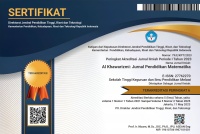BERPIKIR KREATIF DALAM MENYELESAIKAN MASALAH LUAS BANGUN DATAR MENGGUNAKAN TANGRAM
DOI:
https://doi.org/10.46368/kjpm.v1i1.271Abstract
Abstrak: dalam penggalian ini dasari oleh rentannya kemampuan berpikir kreatif siswa sekolah menengah pertama dalam menyelesaikan luas bangun datar, sehingga pengendalian dilakukan menggunakan media tangram dalam proses pembelajaran. Mengenai arah dari penggalian ini adalah bagaimana tingkat kemampuan berpikir kreatif siswa ketika mengatasi persoalan luas bangun datar menggunakan tangram. Jenis penelitian yang digunakan adalah deskriptif kualitatif. Hasil penggalian akan memberikan gambaran secara rinci dan mendalam mengenai tingkat kemampuan berpikir kreatif siswa kelas VII A SMP Negeri 1 Ella Hilir dalam menyelesaikan masalah luas bangun datar mengunakan tangram. Selanjutnya hasil penelitian menunjukan bahwa siswa menjawab soal no 1a dimana memiliki indikator kelancaran dan keterincian sehingga jumlah persentase siswa yaitu 32% untuk kategori tinggi, pada kategori sedang yaitu 20%, sedangkan untuk kategori rendah yaitu 48%. Sedangkan untuk soal 1b, menunjukan bahwa siswa menjawab soal no 1b dimana memiliki indikator kelancaran dan keterincian dipersentasekan sebagai berikut siswa yang memiliki kategori tinggi yaitu 8%, untuk kategori sedang yaitu 8%, sedangkan untuk kategori rendah yaitu 84%.
Â
Kata Kunci :Berpikir Kreatif, Bangun Datar, Tangram.
                             Â
Abstract: This research is motivated by the low ability of creative thinking of junior high school students in completing the area of flat wake, so researchears conduct research using tangram media in the learning process. The purpose of this study is to axamine how the level of creative thinking ability of students in solving the problem of wide flat wake using tangram. The type of research used is descriptive qualitative. The results of this study will show a detailed and in-depth picture of the level of creative thinking ability of grade VII A students of SMP Negeri 1 Ella Hilir in resolving the problem of wide flat shape using tangram. Furthermore, the results showed that students answered questisons no la which have indicator of fluency and deteail so that the percentage of students is 32% for the high category, in the medium category, in the medium category is 20%, while for the low category is 48%. Whereas for question no 1b, it was shown that students answered question no 1b which had indicators of fluency and detail being presented as follows students who had a high category of 8%, for the medium category which was 8%, whereas for the low category it was 84%.
Â
Keywords : Creative Thinking, Flat Wake, Tangram.
References
Arikunto, S. (2010). Manajemen Penelitian. Jakarta: Rineka Cipta.
Fardah, D. K. (2012). Analisis Proses Dan Kemampuan Berpikir Kreatif Siswa Dalam Matematika Melalui Tugas Open-Ended. Matematika FMIPA UNNES. Jurnal Kreano, ISSN: 2086-2334. Volume 3 nomor. 2 Desember 2012
Jakni. (2016). Metodologi Penulisan Eksperimen Bidang Pendidikan. Bandung: Alfabeta.
Karso. (2014). Pendidikan Matematika 1. Tanggerang: Universitas Terbuka.
Meika, I & Asep S. (2017). Kemampuan berpikir kreatif dan pemecahan masalah matematis siswa SMA. Universitas Pendidikan Indonesia Bandung. JPPM Vol. 10 No. 2 (2017)
Miles, M.B & Huberman A.M. (1992). Analisis Data Kualitatif. Terjemahan oleh Tjetjep Rohendi Rohidi. Jakarta: Universitas Indonesia.
Pratiwi, dkk. (2018). Desain Pembelajaran Materi Luas Bangun Datar Menggunakan Tangram Di Kelas IV. Jurnal Inovasi Pendidikan, Volume 8, No 2, Hal: 47
Rahmani, W & Nurbaiti W. Meningkatkan Kemampuan Berpikir Kreatif Matematis Siswa Melalui Media Tangram. Universitas Muhammadiyah Jakarta. Jurnal Pendidikan Dasar dan Pembelajaran. Hal: 2
Sugiyono. (2018). Metode penelitian kuantitatif, kualitatif, dan R&D. Bandung : Alfabet
Sujarwo, E & Tri N. H. Analisis Kemampuan Berpikir Kreatif Siswa Kelas VIII SMP Dalam Menyelesaikan Soal Luas Bangun Datar. Universitas Kristen Satya Wacana. (online) Volume 2 Nomor 1.
Surjawo. 2011. Model-Model Pembelajaran Suatu Strategi Mengajar. Yogyakarta: Venus Gold Press.
Trianto. (2009). Mendesain Model Pembelajaran Inovatif-Progresif. Jakarta: Kencana
Youwanda. (2011). Analisis Proses Pemecahan Masalah Matematika Siswa Menegah Pratama
Downloads
Published
How to Cite
Issue
Section
Citation Check
License
Authors who publish with this journal agree to the following terms:
1. Authors retain copyright and grant the journal right of first publication with the work simultaneously licensed under a Creative Commons Attribution License that allows others to share the work with an acknowledgement of the work's authorship and initial publication in this journal.
2. Authors are able to enter into separate, additional contractual arrangements for the non-exclusive distribution of the journal's published version of the work (e.g., post it to an institutional repository or publish it in a book), with an acknowledgement of its initial publication in this journal.
3. Authors are permitted and encouraged to post their work online (e.g., in institutional repositories or on their website) prior to and during the submission process, as it can lead to productive exchanges, as well as earlier and greater citation of published work.






